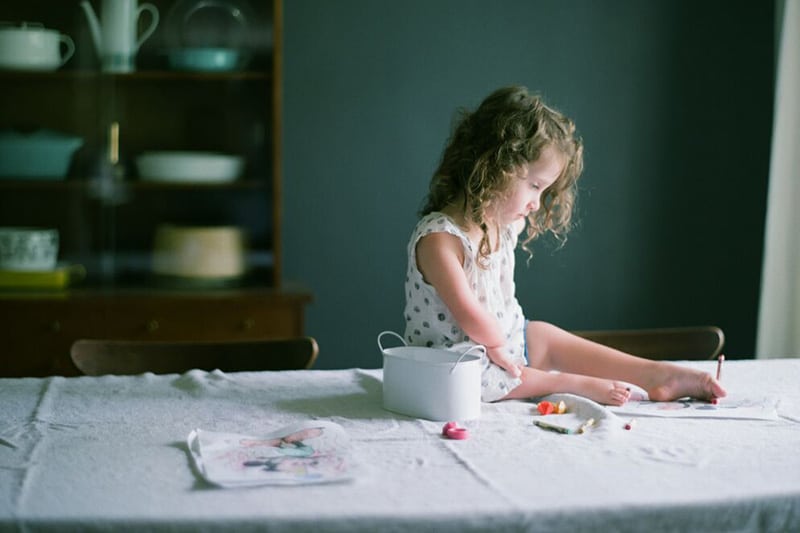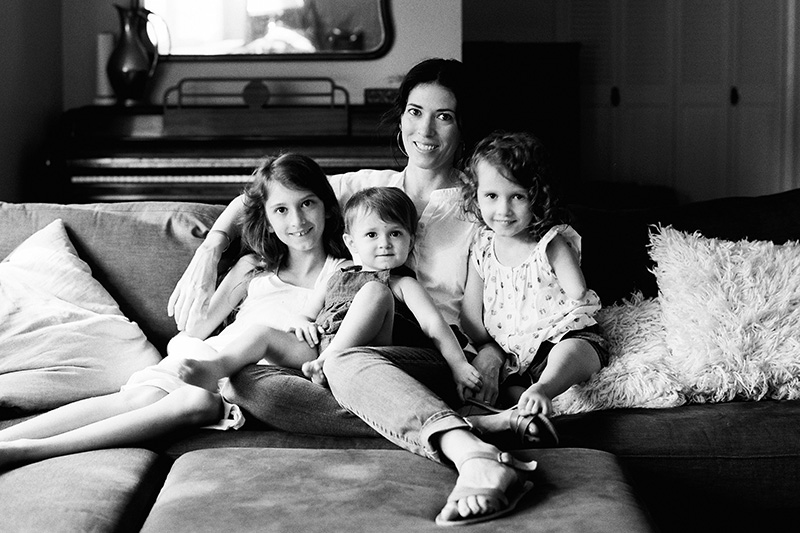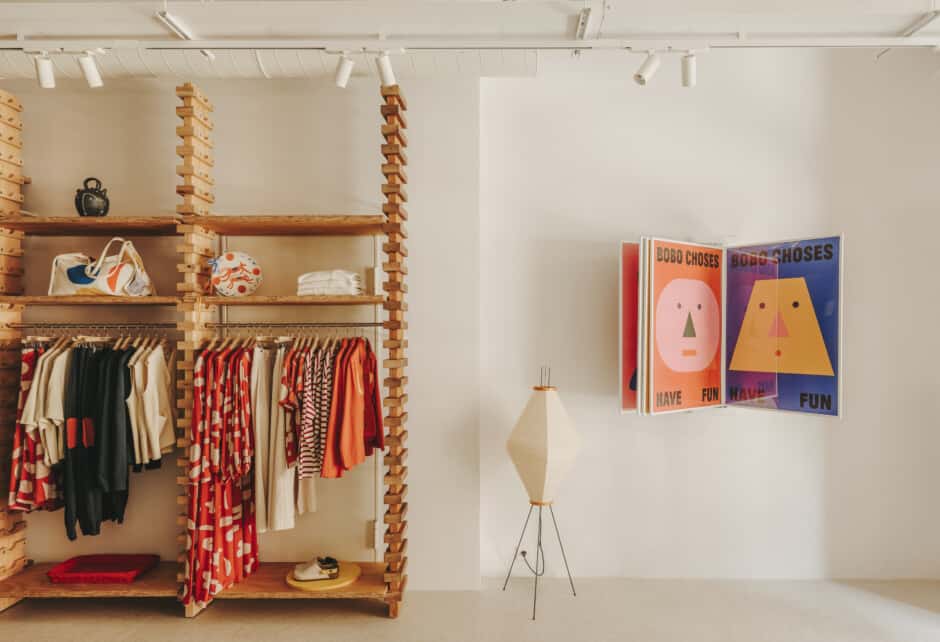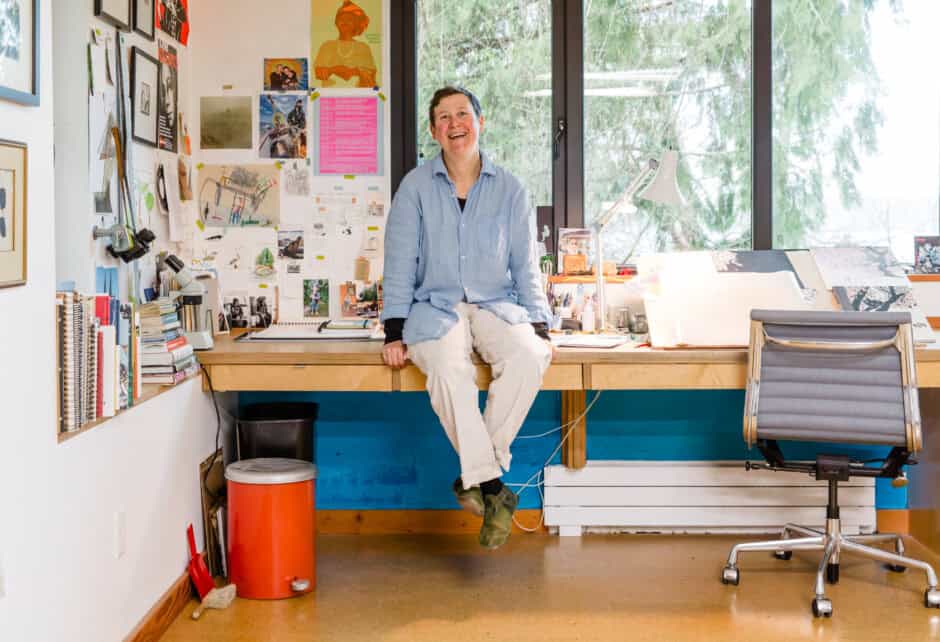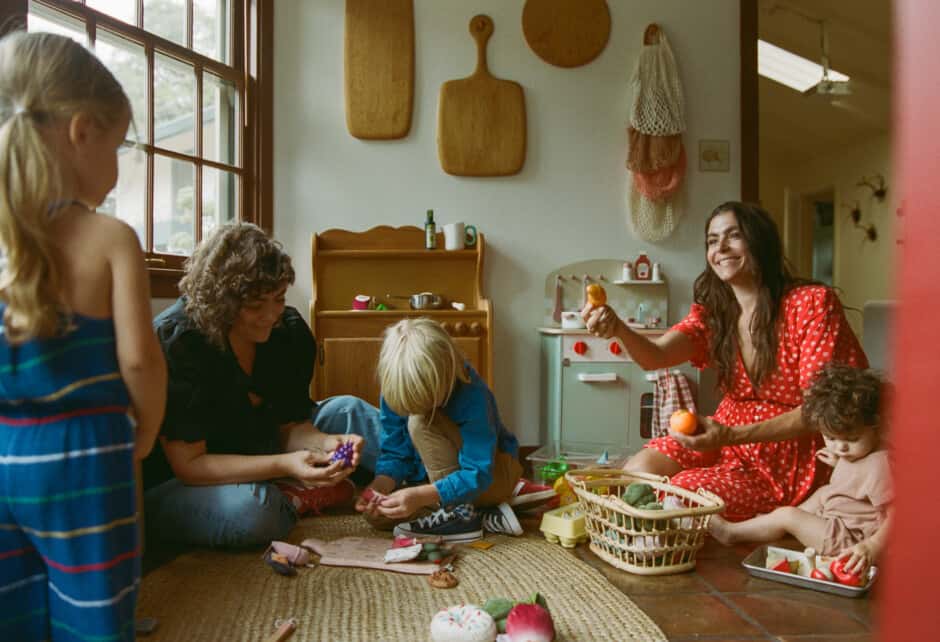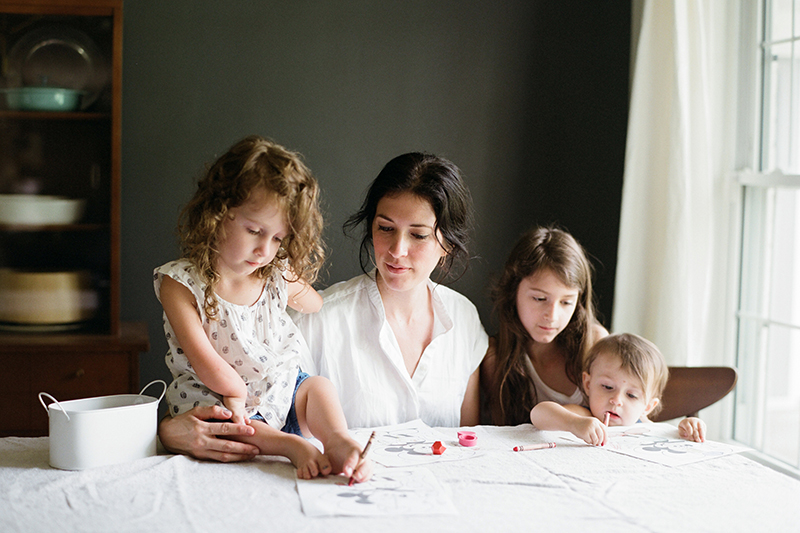
One Mother On Her Child’s Limb Reduction Complex Diagnosis
Written by Katie Hintz-Zambrano
Photography by Photos Courtesy of Momoko Fritz
According to the CDC, one in every 33 children is born with a birth defect. Some of these abnormalities are invisible to passerby, whereas others are very visible and something a family is not only challenged with at home, but every time they step out the door. Such is the case for Amy Webb, a mother of three whose second daughter, “Lamp,” was born with Microgastria and Limb Reduction Complex. As she explains in her blog This Little Miggy, this essentially means she has a small stomach and limb differences on both arms and both legs. Here, Amy tells her touching and inspiring story.
Tell us about the moment you found out Lamp would have special needs.
“I remember that day well and when I replay it in my mind it’s like watching a movie. I see our family of three—my husband, our oldest daughter, and myself—meeting in the parking lot of my OB’s office on a sunny Friday afternoon, so giddy with excitement as we all go in together for the big gender-revealing 18-week ultrasound. In my mind, my husband and I are all smiles, holding our daughter’s hand and swinging her in the air as we bounced into the doctor’s office with the sun shining all around. One thing that stands out is that since we were leaving for vacation in a couple of days, I had a few errands to run, and immediately after the appointment I was going to take my daughter to my friend’s house so she could watch her for a couple hours while I ran those errands. This same friend had recently been pregnant and had gone through her own terrible ordeal where she ended up losing a precious baby girl just about two months prior. In fact, we had the same OB, so as I was on the phone with her in the parking lot finalizing plans, I remember getting off the phone and saying ‘Wish us luck!’ and I immediately wanted to kick myself. Obviously I didn’t mean to be insensitive, but I felt horrible. In hindsight, the sunshine, the smiles, and this conversation all seem like an obvious theatrical foreshadowing for what was about to happen. During the actual ultrasound I told the technician that I’ve been a little worried because I haven’t felt the baby move that much. She immediately tells me that my placenta is on the tummy side of my uterus and therefore I probably can’t feel the baby that well. She then says, ‘There’s the heartbeat—it looks great!’ And I relax. Everything is going to be fine. My husband, my daughter, and I are all chatty while the tech is rather quiet, but I didn’t really notice that until later. When it comes to telling us the gender she said in a very anti-climatic, almost stoic tone, ‘I think it’s a girl…I can’t get a good look, but I think it’s a girl…’ And I’m like, really? That’s how you tell us this exciting news? But at the same time I was too excited to notice. I really, really wanted another girl. The tech kept working, being super quiet, and then she suddenly gets up. Stunned I said, ‘Is that it?’ She quickly says, ‘I’ll be right back.’ And walks out. My husband and I look at each other and immediately our hearts drop. He then says, ‘I feel like I didn’t see an arm on the baby…’ What? What are you talking about? I couldn’t even process what he was saying or that it might possibly be about this baby I was carrying. That sentence had no relevance in my world and whatever he thought he saw or didn’t see was clearly just wrong. And for a split second I imagined that I might have a kid without an arm and, again, I couldn’t even process the idea. This seemed like the most crazy suggestion I had ever heard in my life. Then the doctor walked in. When I asked him if everything was okay, he said ‘No.’ And I will never forget the following sentence: ‘While your baby’s head, heart, lungs, spine, and kidneys look fine, it’s the limbs. All of them…are deformed, misshapen, or are missing bones altogether.’ BOOM. Just like that our lives were forever changed. The doctor kept talking and using terms like ‘skeletal dysplasia’ and ‘dwarfism.’ The words were pouring out of his mouth so quickly like water over my head that I was struggling to breath, drowning in what he was saying. When I finally opened my mouth to ask a question, I got about halfway through before I burst into tears, buried my head in my hands and sobbed. I think that’s the only time in my life I have legitimately done that. We left the office with no answers. This completely unknown condition was either ‘incompatible with life,’ or if she did live, our baby was clearly going to have a host of issues all of which would remain unknown for an indefinite amount of time.”
What were your initial feelings in that moment?
“Our initial reactions could be summed up in the word fear. Again, at the time we didn’t know it was ‘just’ going to be a condition that would only affect her limbs, which was still very daunting on its own, so all these scenarios were playing out in my mind and I think the strongest desire I had was just for the entire situation to disappear. I just wanted to turn back the clock and return to our ‘perfect’ family and our ‘perfect’ life. We were sad for the baby, we were sad for ourselves, and we were really fearful for the future.”
Have those feelings changed over time?
“Going back to that terrible day when we had our ultrasound, everything about our situation looked bleak. The doctors had no idea what was going on, we had no idea what was going on, and frankly all signs were pointing to ‘this is a bad situation with a bad outcome.’ Now when I look back I think, ‘Oh, it was just Lamp. It was her all along.’ What I realize now is that an ultrasound machine is not a future-predicting machine. Don’t get me wrong, I’m grateful for the information it gave us and I reacted how any normal person would and should react. But it was just a small piece of information in the total package of who our daughter is. If that ultrasound machine had been 100% accurate it would have told us that this little girl will also be born with extra awesome, that she will have a joyful disposition and light that others will be drawn to. It would have told us that she is bright, full of love and laughter, and that our lives will be so much better with her in it. To say I am so grateful to be a mom to all three of my girls, individually and collectively, is an understatement. I want so badly for future mothers of children with disabilities to understand that it’s going to be okay, most likely better than okay, most likely amazing. The love will be there and it will see you through. It will definitely change your life, but for the better. You’ll be given a new set of eyes and the world will never look the same again.”
What were your next steps after finding out?
“Of course, we wanted as many answers as we could get right away. Our OB was going to set up an appointment with a fetal maternal specialist the very next week. But we were supposed to leave for a week-long vacation with extended family in just two days. Our gut instinct was to cancel our vacation. How could we go on vacation with this news just hanging over our family like this? Then the more we thought about it we realized that there wasn’t anything we could do to change the situation and that a vacation might be a really good thing for our family and our doctor agreed. We said a lot of prayers, felt a good measure of peace, went on vacation, and had a wonderful time. It was exactly what we needed. When we got back we had a level 2 ultrasound—the first of many, many ultrasounds—where we were given details about each limb. This gave us a surprisingly accurate idea of what our daughter’s limbs would look like and I was grateful to have this preparation. We also did a number of tests and screenings to try and determine if there was a condition or syndrome. It wasn’t until after birth that we learned she had no other major medical issues and only time would tell as far as cognitive issues. The rest of my pregnancy I was watched very closely with weekly ultrasounds, since just the fact that she had ‘birth defects’ immediately put her at a higher risk for being stillborn.”
How did the rest of your pregnancy and months leading up to birth unfold?
“This pregnancy was an emotional rollercoaster from start to finish. I had actually miscarried the month before I got pregnant with Lamp. I have no idea how I got pregnant so quickly as we certainly weren’t trying. So, we were just coming off of a miscarriage when I find out I’m pregnant again. Then, about 6-8 weeks in, we had a couple of threatened miscarriages—unexplained bleeding—and think, oh here we go again! But miraculously there was always a heartbeat. Then came the 18-week ultrasound with the devastating news of her limbs. After the ultrasound we had many, many tests and meetings with specialists and always more questions than answers. There were a lot of surreal moments. I’ll never forget sitting around a table at our local children’s hospital (one of the best in the country) and having a team of specialists tell us ‘I’ve never seen anything like this.’ Or there was the time I cut out a baby picture of our older daughter and using the notes from our level 2 ultrasound I reconstructed what our new daughter’s body would look like—which, again, was surprisingly accurate—and I remember thinking, ‘Out of all the things I’ve worried about in my entire life, I could have never imagined this scenario.’ On top of that, there were false labors, bedrest, and sickness that really made it a very difficult pregnancy until the day before delivery. But towards the end of the pregnancy I started to feel the regular, old excitement of ‘I’m having a baby’ return, which was really wonderful. I knew that no matter what, I was going to love this baby and I was grateful to have that thrill and excitement of anticipation return before she was born.”
How did the birth go?
“I had a scheduled C-section at 37 weeks, since there were still some concerns about her overall health. The day of her birth was a wonderful and joyous day. There was a concern that she might have breathing issues, but as soon as she was born and breathing on her own we knew we had cleared a big hurdle. She needed to go up to the NICU to be assessed, but since she appeared to be doing okay, my OB asked the team if they would let me hold her on my chest before whisking her away. I got to hold my sweet baby within minutes of my C-section and I have always counted that as an enormous blessing. She was then taken to the NICU where she was checked out and declared otherwise healthy and sent back down to me in about an hour. It seemed like we had only heard bad news upon bad news during the pregnancy and now after birth we were receiving only good news. She was tiny and sweet and perfect. She didn’t have 10 little fingers or 10 little toes, but she was absolutely perfect.”
How were Lamp’s baby months and years?
“Such a mixed bag of emotions! The good news is that as a newborn Lamp was just as helpless as any other newborn, so in that sense there was a lot of normalcy. And she was a delightful baby, which I was very grateful for because my first daughter had been rather colicky. When she was 4 months old I was still feeding Lamp 12-14 times a day. Long story short, I insisted the doctors take a look at her stomach and as it turns out she had an exceptionally small stomach and she ended up having a g-tube placement surgery at 6 months old. That first year we spent a lot of time at the hospital. I’ll never forget going to the hospital an unplanned three times in one day and just thinking, ‘Is this ever going to end?’ That first year was a rollercoaster. Additionally, physical development was slow. She didn’t sit up independently until 8 months old, and didn’t scoot for the first time until 16 months. So, not to have mobility for that long was sometimes hard. Added to the fact that she was very limited with her upper limbs as far as play goes. That being said, she was just the most patient baby in the world and very unfrustrated by these ‘limitations.’ It was also during this time that we fitted Lamp for her first upper prosthetic. Lamp no longer uses a prosthetic arm, which is a whole different, much longer conversation. If there’s anything I would want people to understand about prosthetics it’s this: There is a BIG difference between the practicality and usefulness of upper and lower prosthetics especially for congenital amputees. The media makes it seem like all you need to do is 3-D print a prosthetic hand and boom—problem solved. This is not the case. I’m certainly glad we had our go at prosthetics, but I’m even happier that we walked away from them.”
How have the following years been?
“I could (and maybe will) write a book about how the following years have been. In a few words, they’ve been amazing. Our daughter, like our other two girls, is amazing. Sure, some years have been tougher than others, you know, ’cause life, but definitely brighter than we could have ever imagined after that first ultrasound. I assumed that she would get super frustrated when she realized she couldn’t grab toys, crawl/walk, or do things she saw her big sister doing. I was wrong. She was so content and really just patient with herself and us. That was a gift. As she grew into toddlerhood she astounded people with her sharp vocal skills—she started speaking in small, yet full sentences by 15 months old. During this time she was also doing therapy 3 times a week, which helped immensely, and figuring things out on her own. She started grabbing things with her feet and then she started to be able to feed herself with her feet. Finally, it was during a chance meeting with another limb different girl who has differences very similar to Lamp, but who is a few years older, as I watched them pass markers back and forth between their feet, drawing little pictures for each other, it was then that I realized her feet were going to be a big part in who she is and how she uses her body. Another big deal was when Lamp started to learn to drive her power chair and the day we finally brought it home. It took me a while to admit that I was really hesitant to bring her chair home. Having her in a stroller definitely provided a somewhat inconspicuous cocoon of safety. Having a 2 year old, with limb differences, driving a power chair around was like putting a giant spotlight on her everywhere she goes. Blending in was no longer an option. But it also gave her freedom and, of course, we were really excited to see her patience finally being rewarded with mobility. Now Lamp is 5. She has a second power chair, just started kindergarten, loves her friends, and is actually a cheerleader for our local school district. Our main concerns with Lamp boil down to social acceptance. We were lucky to have a special presentation given to her entire school, talking about her differences and highlighting some of the tools she uses on a daily basis to help educate the kids around her.”
How hard are the stares and double-looks you guys get everyday?
“I liken being Lamp’s mom to having a celebrity for a child. People stare a lot and people remember her wherever we go. Fortunately, most of the stares are kind people smiling and often really amazed at what a good driver she is! Of course, there are interactions that are much more difficult and most of these have happened with children and it’s always worse if it’s at a new place with a lot of children that Lamp doesn’t know—for example, a playground, a school, or even one child’s birthday party where we didn’t know any of the other kids. I believe very strongly that I have a role in educating the children we come in contact with, and therefore I have learned that the best way is just to face it head on. If I see kids staring and pointing at Lamp, I will immediately engage them in a conversation about differences. It’s taken me almost five years, but I finally feel like I have a rough formula for dealing with this. This is mostly meant to be used with young children approximately 8 and under. Older children should hopefully start to know a little about boundaries, and I would not consider having this type of discussion with an older child (or adult) in front of Lamp appropriate.”
1. Questions Are Okay
“The emotions that a child feels when seeing or meeting another child with special needs can range from curious to nervous to scared to just plain confused. Let your child know that if they have a question it’s okay. Try not to shush them and turn them away from the child they just encountered. This only reinforces an exclusionary mentality. If your child points at Lamp and says ‘What happened to her arm?’ my suggestion would be to get down on their level and have the whole ‘Some people are born differently’ conversation right then and there. Reference friends or relatives who have a wheelchair, walker, glasses, etc. I know this is the hardest part because we think the kind thing is to shush our children and walk away. But walking away implies that there is something wrong with special needs kids and we don’t interact with them. So, please, do your best to stay. Remember, Lamp knows she has limb differences—it doesn’t hurt her feelings to have it explained in front of her. What does hurt her feelings is having a rude interaction and then having that potential playmate taken away before things are set right.”
2. Reinforce Kindness
“While it’s important not to shame kids for their curiosity, it’s also very important to let children know in no uncertain terms that some things are not okay. It’s not okay to point, stare, laugh, call names, or use mean words. Even if your child does this innocently (‘She’s weird!’ ‘Yuck! Why does her arm look like that?’) please correct them. For example, ‘That’s not a nice word and that might hurt her feelings’ or ‘That would really hurt your feelings if someone laughed at you.’ It can be said kindly, it can be said firmly, but it has to be said. Curiosity can quickly turn to cruelty if young children are left unchecked.”
3. Find Common Ground
“Once your child has some understanding that some people are just born differently, now is a great time to find some common ground. ‘She may be a little different, but she’s mostly the same as you. I bet she likes a lot of the same toys/games/food that you like.’ You can then ask the child or the child’s caregiver what they like to do. Establishing this sameness is key. This is when the light goes on and children realize, oh…she’s just another kid, like me.”
4. Emphasize Strengths
“This one won’t be as easy to do if you don’t know the special needs child personally, but as Lamp’s mom I try to emphasize that she is differently-abled. Yes, there are some things she can’t do, like walking, which is why she drives a power chair, but OMG, she can drive a chair! Or I always say, you want to know something really cool? Lamp can write with her feet! This is when you see the jaws drop—literally. Again, it’s super important for kids to understand from a young age that disabled really means differently-abled.”
Do you have any advice for mothers of babies with limb differences?
“Yes! As I said earlier, the good news is that a newborn with limb differences is no more or less helpless than any other newborn—in that respect, you’re free to snuggle, love, and enjoy your babe just like you would any other little one. Second, and this will probably sound cheesy, be prepared to be amazed at everything your child will do and figure out on his/her own. Be open to your child doing things in her own unique way and make sure the doctors and therapists your child works with are also supportive of letting your child lead the way when it comes to therapy and doing things in a way that feels most comfortable for her. As your child grows, remember that there is a huge range of how your child’s specific limb differences will affect him/her. I would say the two main challenges will be physical limitations/barriers and social acceptance. Hopefully your doctor is pointing you in the direction of a specialist—usually a pediatric orthopedic surgeon. I would add that you want to find an orthopedic surgeon who really knows limb differences—this can be hard to find, but it’s worth it to look. There are a few big pediatric orthopedic hubs around the U.S., hopefully one is close enough to accommodate your family. Reach out to other limb difference moms online through groups like Lucky Fin Project, Amputee Coalition of America, or me! Googling will surely get you connected with another mom who has a child with similar limb differences or hopefully your hospital/orthopedic surgeon will also be able to connect you with a family who has dealt with similar issues. My last piece of advice would be to educate yourself about tools like prosthetics. As I said above, the feasibility and usefulness of prosthetics for upper limbs vs. lower limbs is really different. This is where finding an orthopedic doctor who knows limb differences makes a huge difference.”
Are there any great organizations that you think folks should know about? What about books, movies, etc.?
“One of the organizations that I feel is doing really great work is Changing the Face of Beauty. This is an organization dedicated to making sure kids of all abilities are represented in the media. One book that I think every parent and preteen should read is Wonder by R. J. Palacio. This is an amazing juvenile lit novel (fiction) that details the experience of a boy born with a severe cranial facial deformity. As a mom of a child with a very noticeable disability, I love that this book really helps others understand what it would be like to stand out in such a drastic way. It’s written with unflinching honesty and yet tenderness at the same time.”
What are your hopes and dreams for Lamp?
“I honestly think the sky’s the limit for Lamp. I hope she always believes in herself the way she does now and that she is able to tap into her true value and worth. I hope that the world will continue to grow in its acceptance of people living with disabilities. I hope that Lamp finds love, true friendship, and fulfillment in her life. Certainly I hope she’ll be happy, but to me that doesn’t mean a life void of pain, but rather learning to cope well the pain, sadness, and disappointment thrown her way. These are basically the same things I wish for all my kids.”
For more on Amy and her family’s journey, check out her blog and Instagram feed.
Share this story

